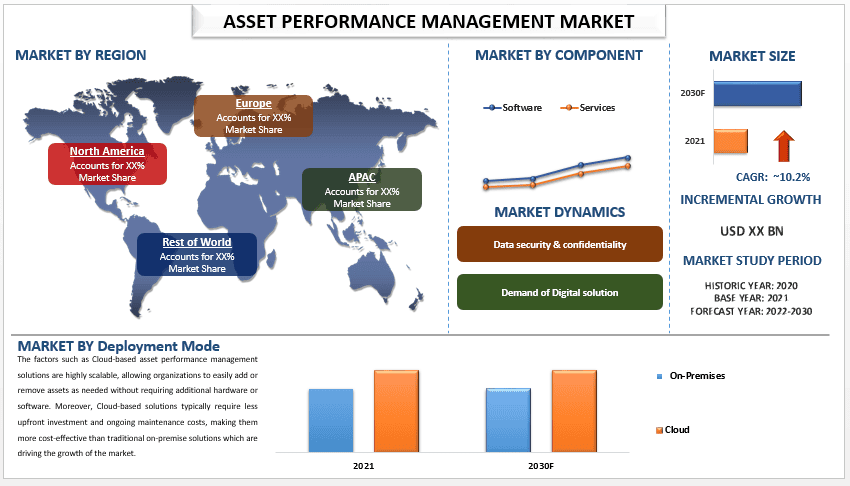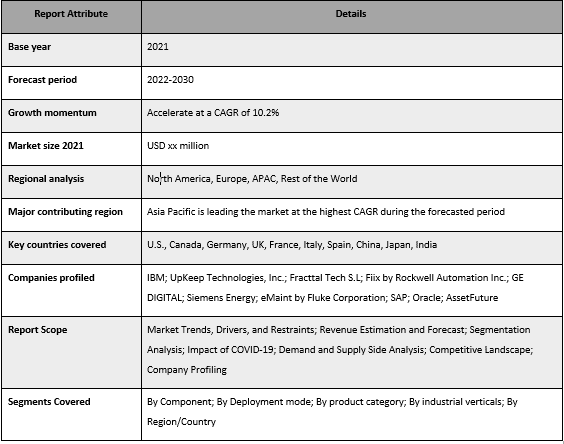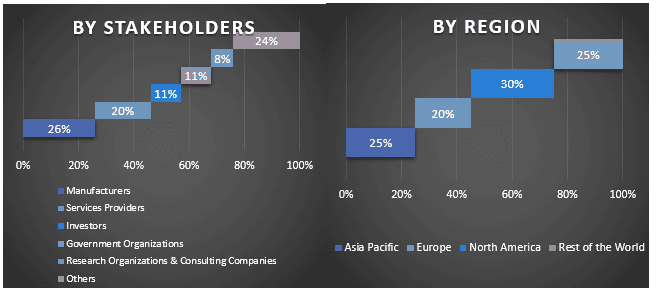
由于对具有成本效益的有效维护的需求不断增长,预计资产绩效管理市场在预测期内将以 10.2% 的强劲复合年增长率增长。此外,随着传感器技术和先进分析工具的日益普及,实时收集和分析工业资产的数据变得更加容易,这使得开发更准确、更有效的 APM 解决方案成为可能,从而推动了市场的发展。资产绩效管理 (APM) 是企业用来优化其物理资产(如机械、设备和基础设施)在其整个生命周期内的可靠性和效率的战略。APM 涉及使用数据分析、预测性维护技术和其他工具来监控和优化资产的性能。
市场上运营的主要参与者包括 IBM;UpKeep Technologies, Inc.; Fracttal Tech S.L ; Fiix by Rockwell Automation Inc.; GE DIGITAL; Siemens Energy; eMaint by Fluke Corporation; SAP; Oracle; AssetFuture
报告中提出的见解
“在组件中,解决方案细分市场将在预测期内以较高的复合年增长率增长。”
根据组件,市场分为解决方案和服务。其中,解决方案细分市场将在预测期内以较高的复合年增长率增长。因为它提供了对资产性能的实时洞察,并帮助企业在潜在问题变成重大问题之前识别出来,从而实现主动维护和维修。因此,这些是推动该细分市场增长的因素。
“在部署模式中,云细分市场在 2021 年占据了市场的主导份额。”
根据部署模式,市场分为本地部署和云。其中,预计云细分市场在预测期内将占据市场的主要份额。基于云的资产绩效管理解决方案具有高度的可扩展性,允许组织根据需要轻松添加或删除资产,而无需额外的硬件或软件。此外,基于云的解决方案通常需要较少的预先投资和持续维护成本,使其比传统的本地解决方案更具成本效益,从而推动了市场的增长。
资产绩效管理市场报告覆盖范围

“2021 年亚太地区在资产绩效管理市场中处于领先地位。”
由于该地区对能源和基础设施发展的需求不断增长,亚太地区在该市场中处于领先地位。由于中国和日本拥有庞大的制造业和对数字化转型的投资,预计将成为该地区 APM 解决方案的最大市场。预计印度、韩国和澳大利亚等其他国家/地区的 APM 市场也将出现显着增长。
购买本报告的理由:
- 该研究包括由经过验证的主要行业专家验证的市场规模和预测分析。
- 该报告快速回顾了整体行业业绩。
- 该报告深入分析了重要的行业同行,主要关注关键业务财务、产品组合、扩张战略和近期发展。
- 详细审查行业中存在的驱动因素、限制因素、主要趋势和机遇。
- 该研究全面涵盖了不同细分市场的市场。
- 对行业进行深入的区域层面分析。
定制选项:
全球资产绩效管理市场可以根据要求或任何其他细分市场进一步定制。此外,UMI 了解到您可能有自己的业务需求,因此请随时与我们联系以获取完全符合您要求的报告。
目录
资产绩效管理市场分析 (2022-2030) 的研究方法
分析历史市场、评估当前市场以及预测全球资产绩效管理市场的未来市场是创建和分析全球主要地区资产绩效管理应用情况的三个主要步骤。进行了详尽的二级研究,以收集历史市场数据并评估当前市场规模。其次,为了验证这些见解,考虑了大量的发现和假设。此外,还与全球资产绩效管理市场价值链上的行业专家进行了详尽的初步访谈。在通过初步访谈对市场数据进行假设和验证后,我们采用了自上而下/自下而上的方法来预测完整的市场规模。此后,采用市场细分和数据三角测量方法来评估和分析与行业相关的细分市场和子细分市场的市场规模。详细的方法如下所述:
历史市场规模分析
第 1 步:深入研究二级来源:
进行了详细的二级研究,通过公司内部来源(如年度报告和财务报表、业绩演示文稿、新闻稿等)以及外部来源(包括期刊、新闻和文章、政府出版物、竞争对手出版物、行业报告、第三方数据库和其他可靠的出版物)获取资产绩效管理市场的历史市场规模。
第 2 步:市场细分:
在获得资产绩效管理市场的历史市场规模后,我们进行了详细的二级分析,以收集主要地区不同细分市场和子细分市场的历史市场见解和份额。报告中包含的主要细分市场包括组件、部署模式、产品类别、工业垂直领域和地区。此外,还进行了国家/地区层面的分析,以评估该地区测试模型的总体应用情况。
第 3 步:因素分析:
在获得不同细分市场和子细分市场的历史市场规模后,我们进行了详细的因素分析,以评估资产绩效管理市场的当前市场规模。此外,我们使用资产绩效管理市场的组件、部署模式、产品类别、工业垂直领域和地区等因变量和自变量进行了因素分析。我们对需求和供应侧情景进行了彻底的分析,考虑了全球资产绩效管理市场领域中的顶级合作伙伴关系、并购、业务扩张和产品发布。
当前市场规模评估与预测
当前市场规模:基于上述 3 个步骤的可行见解,我们得出了当前市场规模、全球资产绩效管理市场的关键参与者以及细分市场的市场份额。所有必需的百分比份额拆分和市场细分都是使用上述二级方法确定的,并通过初步访谈进行了验证。
评估和预测:对于市场评估和预测,我们为不同的因素分配了权重,包括驱动因素和趋势、限制以及利益相关者可利用的机会。在分析这些因素后,我们应用了相关的预测技术,即自上而下/自下而上的方法,以得出 2028 年全球主要市场中不同细分市场和子细分市场的市场预测。用于评估市场规模的研究方法包括:
- 该行业的市场规模,按收入(美元)以及资产绩效管理市场在国内主要市场的采用率计算。
- 市场细分市场和子细分市场的所有百分比份额、拆分和细分。
- 全球资产绩效管理市场中按所提供产品划分的关键参与者。此外,这些参与者为在快速增长的市场中竞争而采取的增长战略
市场规模和份额验证
一级研究:与主要意见领袖 (KOL)(包括主要地区的高层管理人员(CXO/VP、销售主管、营销主管、运营主管、区域主管、国家主管等))进行了深入访谈。然后总结了一级研究结果,并进行了统计分析以证明所述假设。一级研究的输入与二级研究结果合并,从而将信息转化为可行的见解。
不同地区主要参与者的划分

市场工程
采用数据三角测量技术来完成整体市场评估,并得出全球资产绩效管理市场中每个细分市场和子细分市场的精确统计数据。在研究了全球资产绩效管理市场中组件、部署模式、产品类别、工业垂直领域和地区等领域的各种参数和趋势后,将数据分为几个细分市场和子细分市场。
全球资产绩效管理市场研究的主要目标
研究中明确指出了全球资产绩效管理市场的当前和未来市场趋势。投资者可以获得战略见解,以便根据研究中执行的定性和定量分析来确定其投资判断。当前和未来的市场趋势决定了区域层面市场的整体吸引力,为行业参与者提供了一个利用未开发市场从先发优势中获益的平台。研究的其他定量目标包括:
- 分析资产绩效管理市场当前和预测的市场规模(按价值(美元)计算)。此外,分析不同细分市场和子细分市场当前和预测的市场规模
- 研究中的细分市场包括组件、部署模式、产品类别、工业垂直领域和地区等领域
- 定义和分析资产绩效管理行业的监管框架
- 分析与各种中介机构的存在相关的价值链,以及分析该行业的客户和竞争对手行为
- 分析主要地区资产绩效管理市场当前和预测的市场规模
- 报告中研究的区域的主要国家/地区包括亚太地区、欧洲、北美和世界其他地区
- 资产绩效管理市场的公司概况以及市场参与者为在快速增长的市场中保持生存而采取的增长战略
- 深入分析该行业的区域层面
相关 报告
购买此商品的客户也购买了










